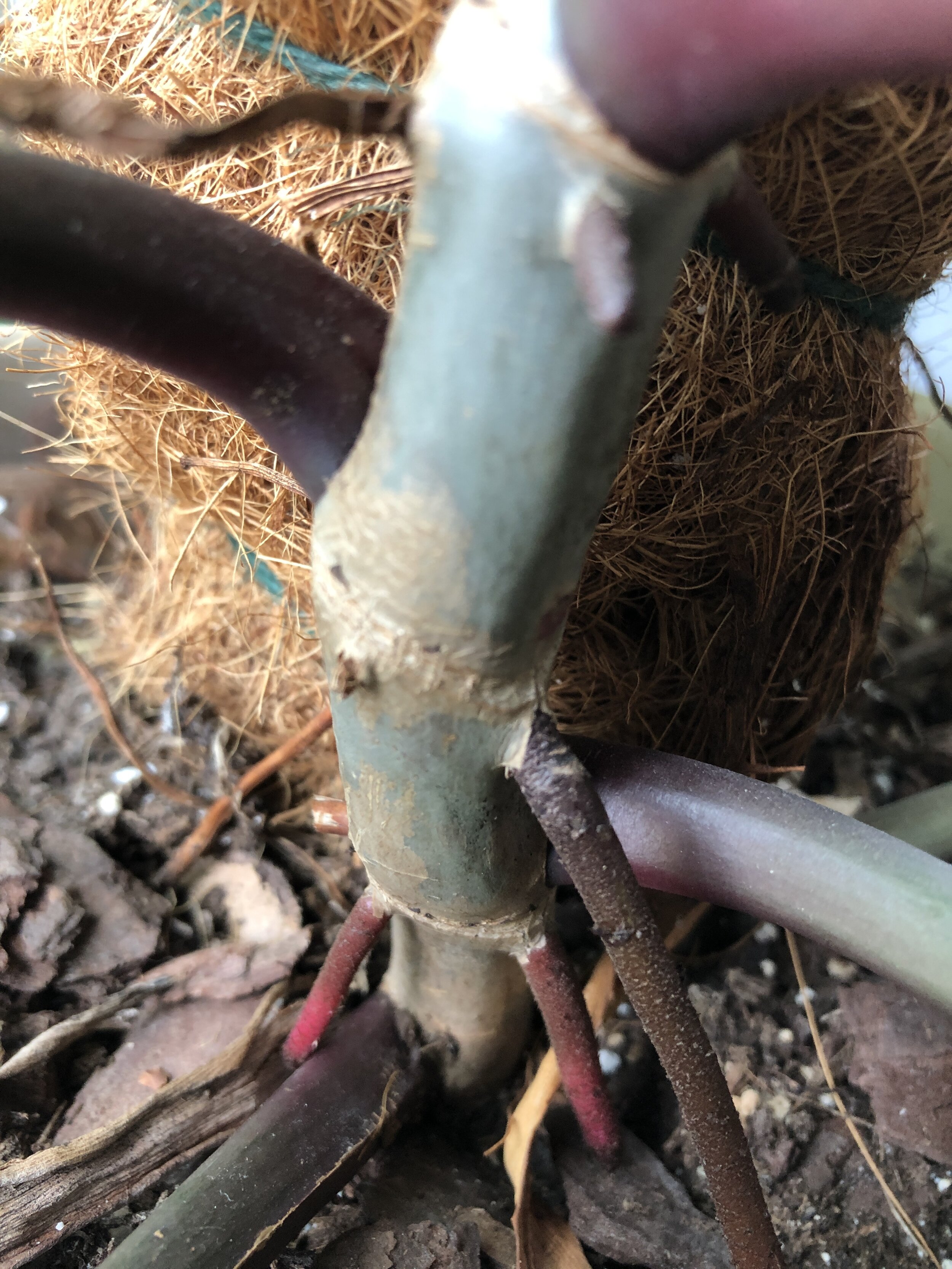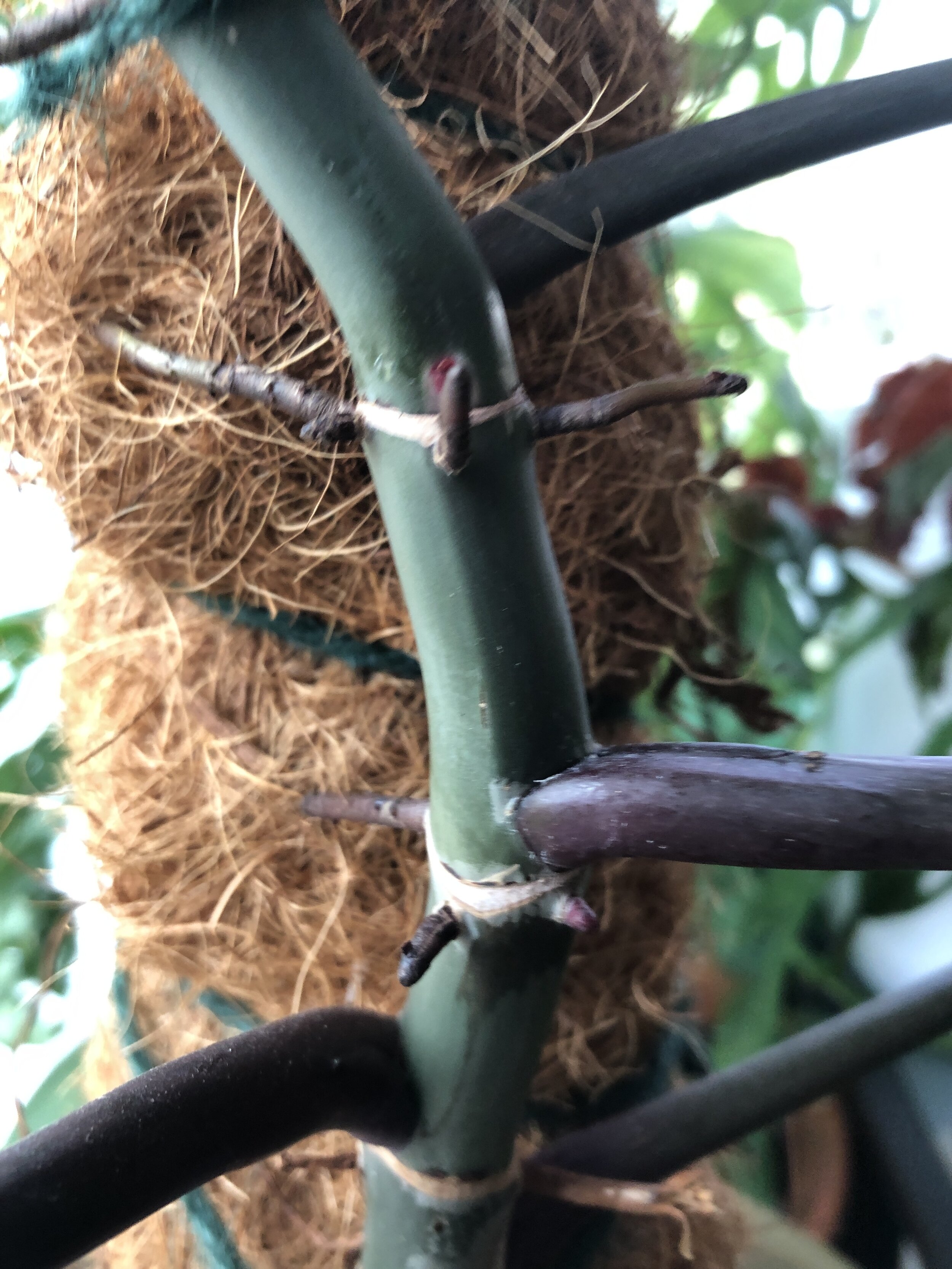The Wonder of Roots.
Roots are arguably the most critical element of plant anatomy. Of course everyone loves foliage, it has a vital duty that won’t be diminished. We plant fanatics love to see a new leaf gracefully unfurling before hardening off and settling into its glorious role of photosynthesizing. Nearly every day is a celebration of foliage, though, so I wanted to make today about celebrating the often unseen and unheard root, or at least a few very specific types of roots.
I don’t know about you, but there have been several times when I’ve had a plant that’s suffered shipping stress, only to shed all of its leaves and be reduced to a stump in a pot. I’ve watered and toiled over a stump in a pot on more than one occasion, and occasionally I’ve been rewarded graciously when the stump begins to produce new growth. This past March, my four-year-old Alocasia suffered a nasty cat induced fall from her perch. She sat as a stump until this week, when I started to see a leaf emerging. My first thought wasn’t in praise and wonder of the roots that worked behind the scenes (or behind the potting mix) to make this miracle happen. My first thought, naturally, was glee over a new Alocasia leaf.
The above example might be about a tuberous Alocasia, but this post will be focusing primarily on the root systems of epiphytic plants, specifically climbing Monstera and Philodendrons. This isn’t to say that this information isn’t applicable to other epiphytes. You might find other plants in your collection where this information is relevant, and that’s wonderful. I chose these plants because so many of us adore our Monstera Deliciosa (variegated or not), our Pink Princess philodendrons, Philodendron Verrucosum, the list goes on and on. I have been meaning to shine the spotlight on this specific group for a while. These root systems have always fascinated me, they’re such a well oiled plant machines. I saw something of wonder a couple of days ago, and it spurred me into action of an adventitious sort. Writing about adventitious roots, that is.
This is my Philodendron Erubescens below, and behind her is Monstera Adansonii. They’ll be the subjects of much of this conversation.
I was wandering around, maybe doing some watering, just completing my daily rounds when I noticed the aforementioned inspiration, as seen below.
Roots! This might not be all that spectacular without the back story. We have another matter at hand here, so to keep it short and sweet, this Philodendron hasn’t had the easiest path. Shipping stress brought her down, and the road to recovery has been a slow and tedious one. When I saw these roots doing exactly what roots should do, I was shocked in the very best of ways at her resilience and tenacity. There is (was, maybe?) a rooted cutting from the same mother plant on the other side of the coir pole. She hasn’t fared well. She’s still sitting in her stump stage. Fingers are crossed for her.
The term “adventitious” comes from the Latin word “adventicius” which means, loosely, “coming from the outside.” It makes sense, though, because adventitious roots come from outside the soil and outside of the traditionally regarded area where roots belong. In fact, adventitious roots can arise from any area along the node or internode. The roots of Epiphytes can be broken down into three varieties. The fibrous or absorbing roots, the clinging (sometimes called climbing) roots, and the epiphytic roots. The former two are what we often consider adventitious.
Fibrous Roots
The Fibrous roots are the horizontally growing roots that, in houseplants, live under the potting mix. In the wild, they might be nestled into a tree crotch filled with leaf litter, shed tree bark, and whatever other debris came there way. The roots are branching, but generally all the same width. This stands in contrast with a taproot system, which has smaller roots branching from one, large anchoring root. Think Carrot. A taproot generally grows vertically with finer branches growing vertically outward from the taproot. Because the functions of the two root systems are so different, they look and work differently. Taproots grow down vertically, as mentioned above, and they emerge first from a seed. Fibrous roots don’t need to come from a seed, they can be grown whenever the plant suffers a stress and needs root support, both literal and figurative support. This amazing ability to spontaneously sprout roots when the need arises makes propagation, or cloning, possible. I’m sure we can all give a sincere tip of the figurative hat to these guys for giving us the gift propagation. The Fibrous roots are shallow, which is why we often hear that epiphytes don’t need large pots. They prefer to grow horizontally, and they share the work load with the other two types of roots. I love my plants too much to dig one up for the sake of photography, but I’m confident that we can all visualize a fine, horizontal root system that branches out from the vine.
Clinging Roots
Clinging roots primarily to help the plant cling to the host for security, though they can also absorb nutrients. They emerge near the nodes, often in more than one location. See below for the climbing roots on Philodendron Erubescens.
Clinging roots require a decent level of humidity to do their job. Without sufficient humidity, they will crisp and dry, rendering them ineffective. This is why newly potted climbers or those with insufficient humidity require velcro, twine, or other methods to tie them to their climbing pole. Until these roots establish (or the plant finds some other means of feeling secure) it is unlikely that the plant will develop the much adored giant leaves that come along with a climbing plant. The leaves are larger because they are in harmony with the environment and the rest of the plant’s anatomy, thus the plant is primed and ready to do some major photosynthesizing, which will lead to more climbing and more energy usage. A hanging plant with smaller leaves and unused climbing roots can still be healthy, it is simply an adaptation that proves unneeded in the hanging plant.
Epiphytic Roots
These epiphytic roots, seen on Monstera Deliciosa, are an amazing adaptation. They absorb water and nutrients from the environment, and should never be cut off. I repeat: please do not cut these roots because someone in the plantiverse somewhere said they’re an unnecessary inconvenience. As plant fanatics, we have to remember that we are bringing a piece of nature into our homes, and I’d wager a guess that we are wrong more often than Mother Nature. Some advice out there will tell you that these are a useless or unsightly part of the plant’s anatomy, but they’re actually beneficial to the plant and to you. Should the plant not receive adequate water or nutrients, it can pull them when available from the air. The Epiphytic roots love a nice misting if you have rainwater or another clean source, and if they become unruly as some might suggest, they can be wound into the pot to keep them organized. I like the look of a chaotic Monstera, so no harm here. Anatomically speaking, these roots are covered with Velamen which helps them absorb from the air. They do not have a root cap, which is an adaptation that helps roots burrow down into the soil by miraculously being able to detect gravity. Generally speaking, a capped root would grow downward in search of stabilization and nutrients. Since Epiphytic roots hang freely, they have no need for caps, finding gravity or burrowing. In the wild, the epiphytic roots would grow until they reached the ground, where they would gather in a heap or dig into the ground for more stability and anchoring, as seen in the second photo above. They may occasionally branch, though it isn’t a primary function and will most likely occur if the root has sustained some damage.
This is by no means a comprehensive list of the types of roots we see in common houseplants. I was feeling particularly grateful for all the work that roots do on a daily basis, and I wanted show some love by to breaking down specific epiphytic roots that are likely observed in many of our homes on a daily basis.
I would love to hear your stories about roots. Really! Please comment below, send me an email here, or find me on Instagram where many a root chat can occur.





